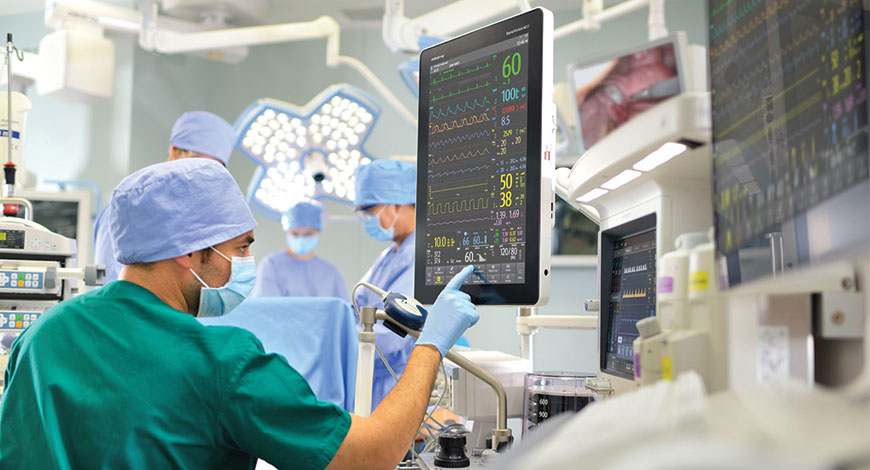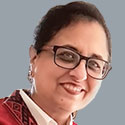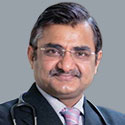MB Stories
Care at a distance

At the start of 2020, widespread use and adoption of remote patient monitoring was still struggling to get off the ground, despite the technology being available for years. This pandemic has exposed the need for the rapid adoption of increasingly innovative digital health technologies.
The monitoring of patients within a clinical setting is changing; new market entrants, new business models, and the IoT revolution are providing more insight into the patient condition through novel data feeds and analytics. The drivers for change are numerous, such as the containment of cost, improvement of patient care and better clinical outcomes. The shift from treating illness to managing health is also demonstrated by an increase in the use of monitoring outside of the clinical setting, in addition to a change in the breadth of what is monitored. This includes both physiological measurements (such as blood pressure, heart rate, and stress) and behavioral measurements (such as medication adherence and compliance). These changes require to re-think traditional approach to the development of patient monitoring technology and to ensure harness the technical enablers safely and effectively to develop products that improve on current monitoring methods, both within and outside of the hospital setting.
Physicians have been challenged to reinvent their practices in order to accommodate their patients during the COVID-19 pandemic. The growing market of remote patient monitoring has become a sought-after solution as indicated by recent increased demand and supply shortages. As such, global remote patient monitoring market is expected to double over the next 5 years. As a result of fear and threat of contracting COVID-19, people are avoiding emergency rooms and doctors’ offices for non-COVID-19 health concerns. This is one of the main drivers that is accelerating the growth of the patient monitoring market. Doctors are not as busy as they were previously and are now partnering with remote patient monitoring companies to sustain their practices and maintain high-caliber medical consulting.
 Dr Anurag Yadav
Dr Anurag Yadav
Senior Consultant CT and MRI,
SGRH
“Connected healthcare is critical for managing patients with disabilities, chronic conditions, or the aging population with mobility impairments. People can continue to live at home, have control of their lives, and still be fully monitored remotely efficiently and effectively. Knowledge is power – and when the patient and the provider have more of it, the outcomes are better and less stressful. There is a deeper understanding of the patient with the dual advantage of trust and transparency. For patients with high-risk pregnancies, serious heart conditions, or dementia, this rapid, real-time information exchange could be an utter lifesaver. The off-site monitoring centers can send timely alerts to enable alteration of treatment prescriptions and the reassurance to the patient that he is safe. The remote devices seem like a web of robotic clinical data exchanges and artificial intelligence interpretations, but these surely save time, resources, and lives”
Demand for patient monitoring equipment is leading to supply shortages, at least through traditional, consumer sources, but many companies stand ready to provide turn-key service to clinicians, including equipment management, home delivery, and a monitoring application. Some electronic health record vendors include such integrations within their software packages. To address these shortages, the FDA, on March 20, issued updated guidance that allows for quicker entry into the market for digital remote monitoring equipment. While this should help consumers looking to build their own remote patient monitoring kits, most companies offering full-service remote patient monitoring solutions should have sufficient stock available to help clinics looking to start remote patient monitoring programs today.
Remote patient monitoring devices provide patients with the ability to better manage their chronic conditions and understand contributing factors to their specific pathologies. In markets that provide universal healthcare, healthcare providers are positioned to take advantage of the continuous data stream from their patients in order to make more informed decisions regarding ordering tests and procedures. In markets that mainly use private healthcare, patients can use remote patient monitoring to understand aspects of their health and seek out specific care, which, in return, will reduce medical fees.
 Dr Vijay Kumar Agrawal
Dr Vijay Kumar Agrawal
Director Critical Care Medicine and Academic Programs,
Senior Consultant Respiratory Medicine,
Metro Heart Institute
“Patient monitoring devices such as oximeters, multipara-monitors, ventilators helped in the monitoring of critically ill COVID-19 patients which allows the measurements of physiological reserves and indicates the effectiveness of therapeutic interventions during the pandemic, which shows the positive impact on the market. The companies are increasing their manufacturing of critical/essential medical device products. The product line includes the patient vital signs monitors, medical consumables for n on-invasive and invasive ventilation and portable ventilators to treat respiratory conditions. Thus, owing to the aforementioned factors the market is likely to have positive impact of pandemic on it. Owing to the rapid evolution of the market in the use of medical technology, medical device companies that are able to launch new innovative equipment will be rewarded with huge benefits”
Businesses are using remote patient monitoring devices to assess worker health and better gauge their safety to return to work. The Food and Drug Administration (FDA) has issued a new policy expanding healthcare providers’ ability to use non-invasive, FDA-approved remote patient monitoring devices that measure patients’ body temperature, respiratory rate, heart rate, and blood pressure. Most COVID-19 patients are asymptomatic, so companies are expected to invest in remote patient monitoring devices to adjust their ready-to-work protocols during the pandemic.
COVID-19 has significantly increased the groundwork for effective remote patient monitoring usage by physicians and patients. The increased awareness of remote patient monitoring products due to companies attempting to restart normal business operations is expected to extend to at-home usage by individuals. This acute acceleration of market growth will be sustained by market expansion benefiting payers and providers through economies of scale, increasing ease of use of home-based remote patient monitoring devices, increasing need for improved healthcare in rural areas, the increasing ageing population and increased incidences of chronic diseases outside of the US and Europe. Future challenges to the growth of the remote patient monitoring market include educating users and patient non-adherence to medical device instructions.
The next trend in remote patient monitoring technology is miniaturization, a process whereby device makers are making their solutions smaller and less invasive while partnering with new companies expand their market share and grow the technology. As remote patient monitoring continues to advance, it stands to have a positive effect of the patients on both patients and the health care providers treating them.
Non-traditional players are entering the market. Remote patient monitoring has seen exponential growth in recent years, boosted further by the widespread adoption of consumer wellbeing monitoring and, more recently, its subsequent convergence with long-term healthcare monitoring in the home and other non-clinical environments. With changes in the reimbursement environment and mounting evidence pointing to the as-yet untapped potential of telehealth in many countries, non-traditional medical device manufacturers are increasingly eager to enter and disrupt the healthcare market.
Technology companies that more traditionally operated in the consumer space, such as Apple, Google, Microsoft, and Amazon, understand the value of structured data and AI, coupled to a well-designed user experience when driving consumer engagement. All of the Big 4 tech companies in healthcare have amassed huge amounts of consumer data, have generated significant insight from that data and have patented many sensing technologies that aim to disrupt the current monitoring market.
Furthermore, they are highly skilled at offering useful digital services alongside beautifully designed wearables and electronic products. Out-of-hospital care therefore seems set to become a viable and increasingly competitive route for new players to enter the healthcare industry, although there will be significant privacy and data ownership hurdles to doing this in the medical space.
Unlike hospital-based monitoring, being able to provide a direct-to-user healthcare offering that can work outside the clinic, will shift demand and therefore directly compete with the offerings of traditional medical device players, introducing disruptive business models in doing so.
Market is seeing these approaches starting to be applied back into the hospital setting, for example with Philips experimenting with monitoring as a service offering. The Arcadia Choice brand, sold exclusively by Amazon, includes blood pressure monitors, cuffs, and glucose monitors that can all wirelessly connect to an app, providing the user with graphs and the ability to share their readings with HCPs.
As the global industry continues to respond to the COVID-19 crisis, all sectors of healthcare system are witnessing extraordinary and innovative ways to deal with this unique challenge. Remote patient monitoring is a critical tool in the healthcare arsenal. It will serve as a complement to telehealth and other tools, giving healthcare professionals across the country access to all the information they need to make the best-informed decisions to treat their patients.
In this environment, patient monitoring will play a central role in helping to enable the actual transformation. For patient monitoring companies to remain competitive in this changing landscape they will need to adapt business models and product roadmaps.
Future monitoring is expected to be more flexible and to reflect the needs of value-based healthcare provision. Required improvements in the quality of care and the avoidance of adverse incidents will drive growth in the use of monitoring in all areas of the hospital. Continuous monitoring of patients’ condition while in the hospital will make it easier for treatment teams to respond to any sudden or gradual deterioration.
Although the number of parameters and patients measured will increase dramatically, advances in monitoring capabilities and careful user-centered design will make this process seamless for healthcare professionals. Advances in analytics and CDS will be necessary to counteract staff becoming overwhelmed by the rising volume of data.
Patients will be mobilized early and further reductions in hospital stays are expected. This will not only be driven by the quality of care in the hospital but also by enabling good quality care away from hospitals. Monitoring technology will allow a more seamless and fast transfer of stable patients to home. Access to data will allow the same therapeutic team to be responsible for their treatment along the care path, something that will allow greater levels of treatment continuity.
Technology will allow clinicians to be more efficient. Improved monitoring systems, with more accurate alarms, will minimize time wasted while telemetry will permit them to attend patients remotely. Integrated data systems and data analytics will enable access to the right patient’s information at the right time.












